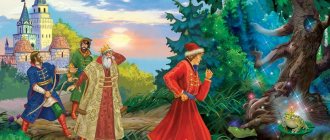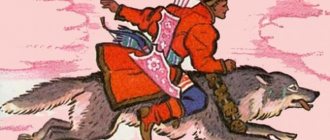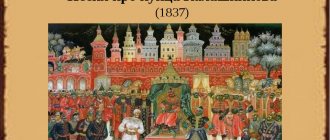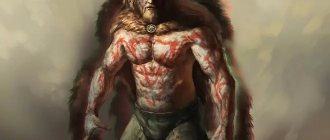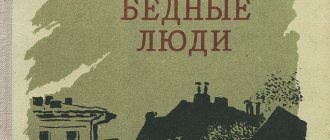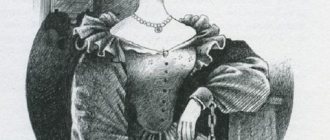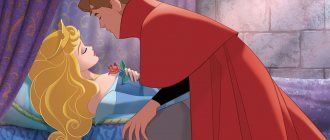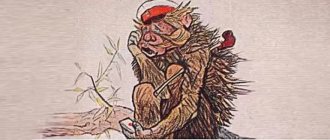The classic Russian folk tale is the most interesting genre of literature for children. Witchcraft, riddles, magical transformations, miracles and adventures - all this is inherent in Russian fairy tales. The main characters of “The Frog Princess” are examples of the best human qualities; they teach wisdom and kindness. Such works cultivate aesthetic taste, love for the native language, teach people to believe in miracles and dream. “The Frog Princess” is a fairy tale, as it contains mythical elements and reincarnations. Such fairy tales are especially fertile ground for children's creativity and the development of artistic and literary abilities.
Main characters
Tsar | The father of three sons, who ordered them to shoot arrows in different directions to find their future wives. He gives tasks to his daughters-in-law to find out which of them is the best craftswoman, housewife, craftswoman. |
Eldest son | His arrow fell on the boyars' courtyard, from there he brought himself a bride. |
Middle son | His arrow hit the merchant's courtyard, the merchant's daughter became his wife. |
Younger son | Ivan found his destiny in the swamp, from there he brought himself a frog. This upset him, but he had to fulfill his father’s will. A brave, dexterous, kind young man. Thanks to the fact that he took pity on the animals (pike, hare, bear), they helped him get the egg with Koshcheev’s death. |
Merchant's daughter, boyar's daughter | Both daughters-in-law turned out to be inept housewives, envious relatives: they neither knew how to bake bread, nor sew a shirt, nor how to dance. They cartoonishly try to repeat the miracles performed by Vasilisa, which is why the Tsar drives them away from the feast. |
The Frog Princess (Vasilisa the Wise) |
The enchanted beauty Vasilisa, a wise wife, a skillful housewife. At night he skins the frog and carries out the king's tasks. She surprises and pleases her father-in-law; he praises her, which makes the rest of her relatives very jealous. At the Tsar's feast, Ivan Tsarevich sees his wife in human form for the first time, runs home and throws the skin of a frog into the oven. There were only three days left until the end of the spell... Because of this, Vasilisa the Beautiful turned into a cuckoo and flew away from her beloved to Koshchei.
Minor characters
Baba Yaga | In search of his beloved, Ivan enters Baba Yaga's hut. She is monstrously ugly, evil and cunning, but her long-standing enmity with Koshchei makes Ivan her ally. He tells the prince where to look for his wife and how to kill Koshchei. |
Koschei the Deathless |
His death was at the end of the needle that was in the egg. It turned out to be very difficult to obtain the “destruction”, because he hid it for many centuries. Ivan Tsarevich obtained the treasured needle and returned his beloved one.
In the school curriculum, the fairy tale “The Frog Princess” is studied in the 5th grade. Characteristics of the characters and analysis of the literary text will be necessary for the reading diary and preparation for the lesson. In the fairy tale “The Frog Princess,” the heroes are traditional and familiar, but they are original and colorful in their own way. Particularly interesting are the descriptions of those pictures when envious daughters-in-law try to surprise the king with their “skills”, competing in baking bread, sewing, and dancing.
Popular topics today
On the reproduction of the painting by G. Nyssa you can see a description of the roads of the Moscow region. Why exactly the Moscow region, you ask? This is indicated by several components of the picture, which the artist thought through to the smallest detail.
In the novel “Heart of a Dog” M.A. Bulgakov pays special attention to the description of modern Moscow reality. The image of Moscow appears before the reader at the very beginning of the work.
Samson Vyrin is the main character in the work The Station Warden. This character is very modest, he lives on a small salary, and is also content with small gifts
Andrei Bolkonsky and Pierre Bezukhov are two main characters who are constantly in spiritual quest and searching for themselves. They are not satisfied with ordinary life
Source
A very brief summary for a reader's diary
By order of the king, his sons had to get married. He ordered them to choose brides in this way: to shoot with a bow in an open field. Where the arrow fell, there everyone had to look for a bride.
The youngest son, Ivan Tsarevich, found his arrow in a swamp. He had to marry a frog.
The frog coped with the king’s tasks better than the wives of his eldest sons. She came to the feast in the guise of a beauty.
Ivan Tsarevich burned the frog's skin so that his wife would always remain beautiful. But because of this, his wife disappeared. The prince found her at Koshchei the Immortal, defeated this villain and freed his wife.
Brief summary (more detailed than summary)
The king had three sons. He ordered them to get married. To find a bride, each of the sons had to shoot a bow at random in an open field. In whose yard the arrow would fly, that’s where the young man should have made the match.
The elder brother's arrow fell on the boyar's yard near the hawthorn tree. The middle brother's arrow flew to the merchant's yard and the merchant's daughter.
- Description of Ivan Tsarevich in the fairy tale “The Frog Princess”
And the arrow of the younger brother, whose name was Ivan Tsarevich, flew to the swamp. There she was caught by a frog frog.
Ivan Tsarevich was upset, but his father forced him to marry a frog.
When the sons got married, the king ordered their wives to bake him bread for the next day.
Ivan Tsarevich came home sadly and told the frog about his father’s order. She calmed him down, put him to bed, and she shed her frog skin and turned into the beautiful Vasilisa the Wise. She went out onto the porch, called her nannies and told them to bake the kind of bread that she ate while living with her father.
In the morning, Ivan Tsarevich saw the beautiful bread and took it to his father. The king really liked this bread. He gave his sons a new order: that their wives should weave a carpet in one night.
Ivan Tsarevich was upset and told the frog about the order. Again she calmed him down and put him to sleep.
During the night, the nannies wove a carpet decorated with patterns and gold and silver.
The Tsar was very pleased and thanked Tsarevich Ivan for the carpet. And he immediately ordered all three sons to come to him along with their wives so that people would look at them.
Ivan Tsarevich came home sad and told the frog about his father’s order. The frog told him to go alone to visit the king. She ordered the prince, when he heard the knocking and thunder, to say that “it’s a little frog coming in a box.”
So he did. A beautiful carriage drawn by six horses drove up to the palace. A beauty came out of her - Vasilisa the Wise.
While the guests were feasting, Vasilisa the Wise poured the remaining drink from the glass into her sleeve, ate it, and hid the swan bones in her other sleeve.
The wives of the older princes did the same.
Vasilisa the Wise began to dance with Ivan Tsarevich. She waved her hand and a lake appeared; she waved her other hand and swans swam across it.
And the wives of Ivan Tsarevich’s brothers began to dance and wave their arms, but from their sleeves only splashes of water and bones flew. One hit the king in the eye. He became angry and drove away the wives of his eldest and middle son.
Ivan Tsarevich hurried to be the first to come home. I found frog skin and burned it. My wife arrived and didn’t find the skin. Vasilisa the Wise was saddened and told the prince that if he had waited a little, she would have been his wife forever. She said goodbye and told Ivan Tsarevich to look for her “far away, in the thirtieth kingdom - near Koshchei the Immortal.”
She turned into a white swan and flew out the window.
Ivan Tsarevich began to spin and walked wherever he could. An old man met him, learned about the prince’s misfortune and said that Vasilisa the Wise’s father was angry that she was smarter than him and ordered her to be a frog for three years.
The old man gave the prince a ball and told him to go where it rolled. Ivan Tsarevich did just that.
He met a bear in the field, and the prince wanted to kill him. The bear asked to be left alive and promised to come in handy someday. The prince took pity on the bear.
He met a drake and a hare on the way, they also asked him not to kill them and promised to be useful. Ivan Tsarevich took pity on them.
On the seashore he saw a pike. She asked to be allowed into the sea. Ivan Tsarevich threw it into the water and went back for the ball. The ball led him to a hut on chicken legs. The prince asked that the hut be facing him in front, and back to the sea. When the hut turned around, the prince went into it.
He saw Baba Yaga on the stove. Baba Yaga asked why the good fellow came to her. Ivan Tsarevich said that first she should give him something to drink and feed, steam him in a bathhouse, and then ask him.
When Baba Yaga did all this, the prince told her that he was looking for Vasilisa the Wise. Baba Yaga said that Vasilisa the Wise is now with Koshchei the Immortal, who is very difficult to defeat. His death is at the tip of a needle, a needle in an egg, an egg in a duck, a duck in a hare, a hare in a chest, a chest on an oak tree. The oak is guarded by Koschey the Immortal.
Baba Yaga said where this tree grows. Ivan Tsarevich reached the oak tree, not knowing how to get the chest from it. A bear came running, tore the oak out of the ground, and the chest broke.
The hare jumped out and ran away. Another hare chased after him and tore the first one to shreds.
A duck fluttered out of the hare, a drake caught it in the sky, hit it, and the duck dropped the egg straight into the sea.
Ivan Tsarevich began to cry, but a pike emerged from the sea and gave him an egg. The prince broke an egg, took out a needle, broke off its tip - and Koschey died.
And Ivan Tsarevich and Vasilisa the Wise returned home and lived happily for many years.
Analysis of the fairy tale “The Frog Princess”. Part 1
We all loved fairy tales as children, and we still do now, although they are called somewhat differently - myths, science fiction, mysticism, detective stories. The fairy tale is a lie, but there is a hint in it...
Analysis of fairy tales
- a surprisingly interesting activity, scientists were fond of it back in the 19th century, and philologists and psychologists continued in the 20th century. The famous psychologist and philosopher Carl Jung believed that fairy tales express the life of the human spirit. In figurative form, the fairy tale tells about the struggle taking place in the human soul.
What kind of struggle is this and what is its meaning? Let's try to figure it out using a specific example of the famous fairy tale about Ivan Tsarevich and the frog princess. Let's read it from the point of view of analytical psychology. The tale begins with a very important event - the king's sons are about to get married.
This is done, from the point of view of a modern person, rather strangely: the fellows shoot arrows. The eldest brother's arrow flies onto the porch of the hawthorn tree, the middle brother's arrow flies into the merchant's daughter's yard, and the younger brother's arrow flies all the way to the swamp, into the forest.
This fact is interesting for us because the arrows of the older brothers fall into a cultivated space, within the city limits, while the arrows of the younger brothers fall far from civilization, into the forest. The forest is an element of wild nature, a place where the forces of instinct dominate.
From Jung's point of view, the forest is a symbol of the unconscious, elemental and irrational forces, whose power over a person and his soul is quite great. Consequently, the younger brother was chosen as the hero of fairy tales not by chance, but due to some qualities of nature and character that he manages to realize in the future. And modern psychologists also claim that the youngest child in the family has greater creativity, that is, creative abilities.
Continuing our analysis of the fairy tale “The Frog Princess,” let us recall the dialogue of the main characters: “Kwa-kwa, Ivan Tsarevich! Come to me, take your arrow, and marry me. Ivan Tsarevich became sad and said: “How can I marry you?” People will laugh at me! - Take it, you won’t regret it! Ivan Tsarevich thought and thought, took the frog, wrapped it in a scarf and brought it to the palace.”
That's how he married the little animal. Only he didn’t act so stupidly, it was not in vain that he thought at first. The fact is that a frog is not a simple animal: in ancient times it was perceived as the animal embodiment of the spirit of water.
In ancient Chinese mythology, there is a divine couple that precedes the appearance of gods and people, the zoomorphic creatures Fu-si and his wife-sister Nyu-wa (Nyu-gua).
From the etymology of names we learn that Nyu means “maiden”, “woman”, and va/gua means “snail”, “deepening”, “frog”, “standing water”. Such ambiguity of the name testifies to its antiquity.
Researchers suggest that Nü-wa could be a spirit of rain puddles, represented as slippery creatures in damp places. Most likely, Nyu-wa was a frog goddess. And now it is clear that Ivan Tsarevich acted wisely, deciding to marry a frog, thereby connecting his life with a divine and powerful creature who promised interesting events and transformations.
And so it happened, because the frog turned out to be a beautiful woman and a great artist. But in a fairy tale, as in life, what is easily given is also easily lost. Unfortunately, struggles and trials are inevitable. According to Jung, this is a necessary condition for the spiritual development of a person, his personality. Jung called this the “law of individuation.” “Through thorns to the stars” - this is how the essence of this law can be briefly formulated. Violation of a prohibition unknown to Ivan (Vasilisa must wear a frog skin for a strictly defined time) led to misfortune and trials. Moreover, the hero’s mistake was typical for a young man - excessive arrogance. Without consulting his wife, he burned her skin. “You didn’t put it on, it’s not for you to take it off.”
To emphasize the hardships and duration of Vasilisa’s search, the tale resorts to symbolic details: three pairs of iron boots must be taken down, three iron loaves must be devoured. Ivan overcomes this long path of hardship and suffering. The old man, Baba Yaga and animals help him.
Who are these fairy-tale characters and what mental forces do they represent? Read further in “Analysis of the fairy tale The Frog Princess” READ MORE
